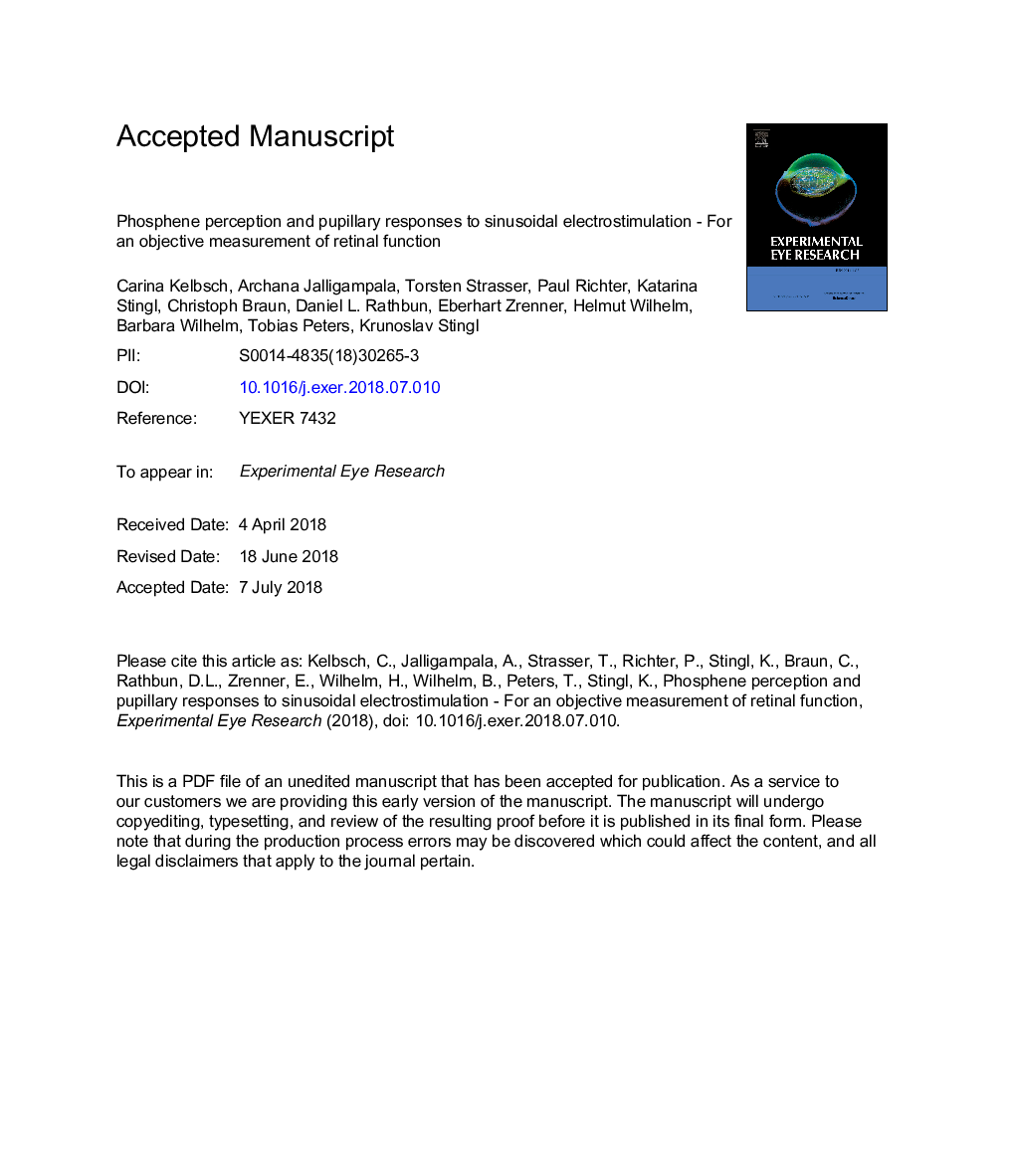| کد مقاله | کد نشریه | سال انتشار | مقاله انگلیسی | نسخه تمام متن |
|---|---|---|---|---|
| 8791889 | 1602546 | 2018 | 23 صفحه PDF | دانلود رایگان |
عنوان انگلیسی مقاله ISI
Phosphene perception and pupillary responses to sinusoidal electrostimulation - For an objective measurement of retinal function
ترجمه فارسی عنوان
ادراک فسفن و پاسخ های ذهنی به تحرک الکتریکی سینوسی - برای اندازه گیری دقیق عملکرد شبکیه
دانلود مقاله + سفارش ترجمه
دانلود مقاله ISI انگلیسی
رایگان برای ایرانیان
کلمات کلیدی
شاگرد، تحریک الکتریکی سینوسی، فسفونها، میکرو الکترود آرایه،
موضوعات مرتبط
علوم زیستی و بیوفناوری
ایمنی شناسی و میکروب شناسی
ایمونولوژی و میکروب شناسی (عمومی)
چکیده انگلیسی
The purpose was to evaluate retinal function by measuring pupillary responses to sinusoidal transcorneal electrostimulation in healthy young human subjects. This work also translates data from analogous in vitro experiments and connects it to the pupillary responses obtained in human experiments. 14 healthy human subjects participated (4 males, 10 females); for the in vitro experiments, two male healthy mouse retinas (adult wild-type C57B/6J) were used. Pupillary responses to sinusoidal transcorneal electrostimulation of varying stimulus carrier frequencies (10, 20â¯Hz; envelope frequency constantly kept at 1.2â¯Hz) and intensities (10, 20, 50â¯Î¼A) were recorded and compared with those obtained with light stimulation (1.2â¯Hz sinusoidal blue, red light). A strong correlation between the sinusoidal stimulation (electrical as well as light) and the pupillary sinusoidal response was found. The difference between the lag of electrical and light stimulation allowed the estimation of an intensity threshold for pupillary responses to transcorneal electrostimulation (meanâ¯Â±â¯SD: 30â¯Â±â¯10â¯Î¼A (10â¯Hz); 38â¯Â±â¯10â¯Î¼A (20â¯Hz)). A comparison between the results of the two stimulation frequencies showed a not statistically significant smaller lag for 10â¯Hz (10â¯Hz: 633â¯Â±â¯90â¯ms; 20â¯Hz: 725â¯Â±â¯178â¯ms; 50â¯Î¼A intensity). Analogous in vitro experiments on murine retinas indicated a selective stimulation of photoreceptors and bipolar cells (lower frequencies) and retinal ganglion cells (higher frequencies) and lower stimulation thresholds for the retinal network with sinusoidal compared to pulsatile stimulation - emphasizing that sinusoidal waveforms are well-suited to our purposes. We demonstrate that pupillary responses to sinusoidal transcorneal electrostimulation are measurable as an objective marker in healthy young subjects, even at very low stimulus intensities. By using this unique approach, we unveil the potential for an estimation of the individual intensity threshold and a selective activation of different retinal cell types in humans by varying the stimulation frequency. This technique may have broad clinical utility as well as specific relevance in the monitoring of patients with hereditary retinal disorders, especially as implemented in study protocols for novel therapies, e.g. retinal prostheses or gene therapies.
ناشر
Database: Elsevier - ScienceDirect (ساینس دایرکت)
Journal: Experimental Eye Research - Volume 176, November 2018, Pages 210-218
Journal: Experimental Eye Research - Volume 176, November 2018, Pages 210-218
نویسندگان
Carina Kelbsch, Archana Jalligampala, Torsten Strasser, Paul Richter, Katarina Stingl, Christoph Braun, Daniel L. Rathbun, Eberhart Zrenner, Helmut Wilhelm, Barbara Wilhelm, Tobias Peters, Krunoslav Stingl,
